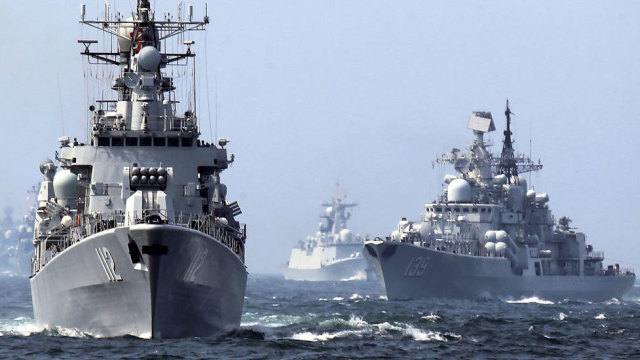A navy or sea force is the branch of a nation's armed forces principally designated for naval and amphibious warfare; namely, lake-borne, riverine, littoral, or ocean-borne combat operations and related functions. It includes anything conducted by surface ships, amphibious ships, submarines, and seaborne aviation, as well as ancillary support, communications, training, and other fields. The strategic offensive role of a navy is projection of force into areas beyond a country's shores (for example, to protect sea-lanes, deter or confront piracy, ferry troops, or attack other navies, ports, or shore installations). The strategic defensive purpose of a navy is to frustrate seaborne projection-of-force by enemies. The strategic task of the navy also may incorporate nuclear deterrence by use of submarine-launched ballistic missiles. Naval operations can be broadly divided between riverine and littoral applications (brown-water navy), open-ocean applications (blue-water navy), and something in between (green-water navy), although these distinctions are more about strategic scope than tactical or operational division.
In most nations, the term "naval", as opposed to "navy", is interpreted as encompassing all maritime military forces, e.g., navy, naval infantry/marine corps, and coast guard forces. The word formerly denoted fleets of both commercial and military nature. In modern usage "navy" used alone always denotes a military fleet, although the term "merchant navy" for a commercial fleet still incorporates the non-military word sense. This overlap in word senses between commercial and military fleets grew out of the inherently dual-use nature of fleets; centuries ago, nationality was a trait that unified a fleet across both civilian and military uses. Although nationality of commercial vessels has little importance in peacetime trade other than for tax avoidance, it can have greater meaning during wartime, when supply chains become matters of patriotic attack and defense, and when in some cases private vessels are even temporarily converted to military vessels. The latter was especially important, and common, before 20th-century military technology existed, when merely adding artillery and naval infantry to any sailing vessel could render it fully as martial as any military-owned vessel. Such privateering has been rendered obsolete in blue-water strategy since modern missile and aircraft systems grew to leapfrog over artillery and infantry in many respects; but privateering nevertheless remains potentially relevant in littoral warfare of a limited and asymmetric nature.

